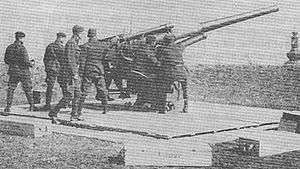9 cm kanon PL vz. 12/20
| 9 cm PL kanon vz. 12/20 | |
|---|---|
 | |
| Type | Anti-aircraft gun |
| Place of origin | Czechoslovakia |
| Service history | |
| In service | 1920-1945? |
| Used by |
Czechoslovakia Nazi Germany Yugoslavia Soviet Union |
| Wars | World War II |
| Production history | |
| Designer | Škoda Works |
| Manufacturer | Škoda Works |
| Specifications | |
| Weight | 6,500 kilograms (14,300 lb) |
| Barrel length | 4.05 metres (13 ft 3 in) L/45 |
|
| |
| Shell weight | 10.2 kilograms (22 lb 8 oz) |
| Caliber | 90 millimetres (3.5 in) |
| Elevation | -5° to +90° |
| Traverse | 360° |
| Rate of fire | 12 rpm |
| Muzzle velocity | 775 metres per second (2,540 ft/s) |
| Maximum firing range | 6,000 metres (20,000 ft) vertical ceiling |
The 9 cm PL kanon vz. 12/20 (Anti-aircraft Gun Model 12/20) was a Czech anti-aircraft gun used during the Second World War. Those weapons captured after the German occupation of Czechoslovakia in March 1939 were taken into Wehrmacht service as the 9 cm Flak M 12(t). Some guns were reportedly captured in Yugoslavia and the Soviet Union as well. Twenty were in Czech service during the Munich Crisis in September 1938.[1] Twelve were in German service between August 1943 and June 1944.[2]
Description
The PL kanon vz. 12/20 was a modernized version of a pre-World War I anti-aircraft gun. It was mounted on a fixed pedestal.
Notes
- ↑ "Statistické údaje výzbroje Čs. armády v roce 1938". 24 March 2005. Retrieved 2009-05-23.
- ↑ Gander and Chamberlain, p. 153
References
- Gander, Terry; Chamberlain, Peter (1979). Weapons of the Third Reich: An Encyclopedic Survey of All Small Arms, Artillery and Special Weapons of the German Land Forces 1939-1945. New York: Doubleday. ISBN 0-385-15090-3.
External links
This article is issued from Wikipedia - version of the 12/6/2013. The text is available under the Creative Commons Attribution/Share Alike but additional terms may apply for the media files.